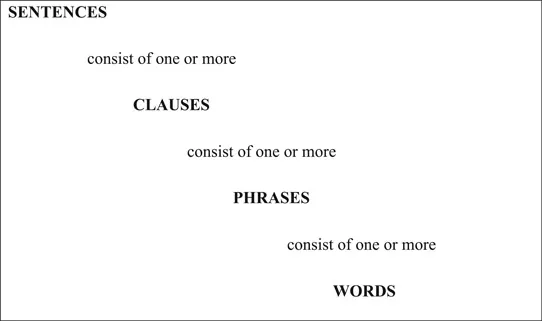
eBook - ePub
English: An Essential Grammar
Gerald Nelson
This is a test
Compartir libro
- 244 páginas
- English
- ePUB (apto para móviles)
- Disponible en iOS y Android
eBook - ePub
English: An Essential Grammar
Gerald Nelson
Detalles del libro
Vista previa del libro
Índice
Citas
Información del libro
English: An Essential Grammar is written specifically for native speakers, beginning with the basics and going on to deal with phrase, clause and sentence structure, word formation and spelling. This fully revised third edition features new material on:
-
- the structure of phrases and clauses
-
- light verbs
-
- nominal adjectives
-
- the Operator
-
- preposition to and infinitival to
-
- the four that s
-
- determiners, prepositions, and common errors
With new exercises and answers for all new sections, this Essential Grammar continues to be the ideal reference for anyone who would like to improve their knowledge of English grammar.
Preguntas frecuentes
¿Cómo cancelo mi suscripción?
¿Cómo descargo los libros?
Por el momento, todos nuestros libros ePub adaptables a dispositivos móviles se pueden descargar a través de la aplicación. La mayor parte de nuestros PDF también se puede descargar y ya estamos trabajando para que el resto también sea descargable. Obtén más información aquí.
¿En qué se diferencian los planes de precios?
Ambos planes te permiten acceder por completo a la biblioteca y a todas las funciones de Perlego. Las únicas diferencias son el precio y el período de suscripción: con el plan anual ahorrarás en torno a un 30 % en comparación con 12 meses de un plan mensual.
¿Qué es Perlego?
Somos un servicio de suscripción de libros de texto en línea que te permite acceder a toda una biblioteca en línea por menos de lo que cuesta un libro al mes. Con más de un millón de libros sobre más de 1000 categorías, ¡tenemos todo lo que necesitas! Obtén más información aquí.
¿Perlego ofrece la función de texto a voz?
Busca el símbolo de lectura en voz alta en tu próximo libro para ver si puedes escucharlo. La herramienta de lectura en voz alta lee el texto en voz alta por ti, resaltando el texto a medida que se lee. Puedes pausarla, acelerarla y ralentizarla. Obtén más información aquí.
¿Es English: An Essential Grammar un PDF/ePUB en línea?
Sí, puedes acceder a English: An Essential Grammar de Gerald Nelson en formato PDF o ePUB, así como a otros libros populares de Languages & Linguistics y Languages. Tenemos más de un millón de libros disponibles en nuestro catálogo para que explores.
Información
Chapter 1
Introducing sentence structure
1.1 The constituents of a sentence
Consider the following sentence:
My father retired when he was sixty.
The sentence consists of seven words in a specific order. However, it is not simply a sequence of seven individual words. Instead, certain words ‘go together’ to form meaningful units, as follows:
[My father] [retired] [when he was sixty].
One of these units (retired) consists of just one word, while the others are multi-word combinations. Regardless of their length, however, these are the basic ‘building blocks’ of the sentence, and they are known in grammar as the constituents of the sentence. A constituent is a word or a string of words that behaves grammatically and semantically as a unit.
So our sentence consists of seven words but only three constituents. Each constituent has its own grammatical function: my father, for example, functions as the Subject (1.4) and when he was sixty functions as an Adjunct (1.8). Every constituent has a complete meaning in itself, and for that reason, every constituent (except the verb) can be replaced by a single word:
[My father] [retired] [when he was sixty]. → [He] [retired] [then].
Similarly:
[After the robbery], [the thieves] [drove] [to a safe house]. → [Then], [they] [drove] [there].
[The postman] [left] [the package] [on my doorstep]. → [He] [left] [it] [there].
[Paul] [married] [his girlfriend] [last August]. → [He] [married] [her] [then].
When you begin analysing the structure of a sentence, it is useful to apply this One-word Substitution Test, because it provides a useful initial overview of the sentence constituents.
1.2 The Grammatical Hierarchy
In grammar, there are only three types of constituents: words, phrases, and clauses. We will discuss words in Chapter 2, phrases in Chapter 3, and clauses in Chapter 4.
The Grammatical Hierarchy (Figure 1.1) provides a very useful summary of how these three types of constituents go together to form a sentence.
Words are at the bottom of the Hierarchy, and for many people, this is the most familiar area of grammar. Most people learn about word classes (nouns, verbs, adjectives, etc) early in their school careers, but do not continue their studies to look at how those words combine to form phrases and clauses. This is unfortunate, since the step from word level to phrase level is actually a very short one. For example, dog is a noun, but the dog, the little dog, and the little dog that I love are noun phrases (3.6). Similarly, happy is an adjective, while very happy and very happy to see you are adjective phrases (3.4).

Figure 1.1
The word-based approach to grammar – looking at word classes only – leads to a ver...